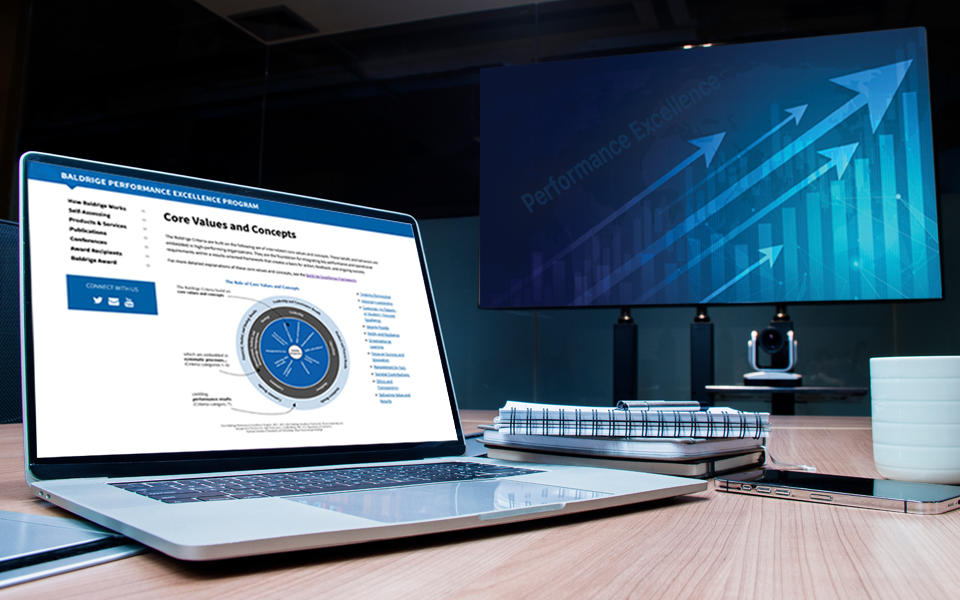This is an original article from the NIST Baldrige blog.

Broadway legend André De Shields (YouTube) once shared his three cardinal rules of sustainability and longevity:
- Surround yourself with people whose eyes light up when they see you coming.
- Slowly is the fastest way to get to where you want to be.
- The top of one mountain is the bottom of the next, so keep climbing!
These rules could apply to how leaders (in business, health care, education, and nonprofit sectors alike) are running their organizations, managing their workforces, and serving their communities. Therefore, these rules can be related to the Baldrige Criteria for Performance Excellence (part of the Baldrige Excellence Framework), particularly the core values and concepts on which the framework is based.
Let’s take a deeper look at De Shield’s rules through the Baldrige lens.
Rule #1
Surround Yourself with People Whose Eyes Light Up When They See You Coming.
What are you doing to achieve and sustain an engaged, mission-driven workforce—as well as satisfied customers and stakeholders? If your people are happy, you’ll know it. And if they’re not, you’ll likely know that, too! You’ll see it in their eyes and in your organization’s data and results. The Baldrige core values and concepts bring these elements into focus. Here are just a few examples:
- Valuing People: A successful organization values its workforce members and the other people who have a stake in the organization, including customers, community members, suppliers and partners, and other people affected by its actions.
- Customer- (or Patient-, or Student-) Focused Excellence: Your customers (or patients, or students) are the ultimate judges of your performance and of product and service quality. Thus, your organization must consider all product and service characteristics, and modes of customer access and support, that contribute to customer satisfaction, loyalty, positive referrals, and ultimately your organization’s ongoing success.
- Delivering Value and Results: Your organization should choose and analyze results that help you deliver and balance value for your key stakeholders. Thus, results need to include not just financial results, but also product and process results; customer and workforce satisfaction and engagement results; and leadership, strategy, and societal performance.
Rule #2
Slowly Is the Fastest Way to Get to Where You Want to Be.
You’ll get nowhere fast without a systems perspective to methodically tackle your work processes, identify opportunities for continuous improvement, and patiently ensure that your product or service is having the desired impact. Many of the Baldrige core values and concepts thoughtfully speak to these points, such as the following:
- Systems Perspective: A systems perspective means managing all the parts of your organization as a unified whole to achieve your mission and strive toward your vision.
- Societal Contributions: Your organization’s leaders should stress contributions to the public and the consideration of societal well-being and benefit. Your leaders should be role models for the well-being of your communities.
- Organizational Learning: Organizational learning includes both continuous improvement of existing approaches and significant change or innovation, leading to new goals, approaches, products, and markets.
Rule #3
The Top of One Mountain is the Bottom of the Next, So Keep Climbing!
As many senior leaders will attest, the quest for excellence is an ongoing journey. The Baldrige core values and concepts model this truth and provide guidance that encourage organizations to persevere through challenges and attain their vision and mission:
- Agility and Resilience: Agility requires a capacity for rapid change and for flexibility in operations. Organizational resilience is the ability to anticipate, prepare for, and recover from disasters, emergencies, and other disruptions, and—when disruptions occur—to protect and enhance workforce and customer engagement, supply-network and financial performance, organizational productivity, and community well-being.
- Focus on Success and Innovation: Ensuring your organization’s success now and in the future requires understanding the short- and longer-term factors that affect your organization and its environment. It also requires the ability to drive organizational innovation. Innovation means making meaningful change to improve your products, services, programs, processes, operations, and business model, with the purpose of creating new value for stakeholders.
- Management by Fact: Management by fact requires you to measure and analyze your organization’s performance, both inside the organization and in your competitive environment. Analysis of performance measures and indicators should support organizational evaluation, alignment, and decision making.
For more detailed explanations of these and other core values and concepts, see the Baldrige Excellence Framework or speak with an expert at IMEC.
Read the original article.



